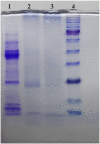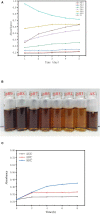Characterization of Theabrownins Prepared From Tea Polyphenols by Enzymatic and Chemical Oxidation and Their Inhibitory Effect on Colon Cancer Cells
- PMID: 35369086
- PMCID: PMC8965357
- DOI: 10.3389/fnut.2022.849728
Characterization of Theabrownins Prepared From Tea Polyphenols by Enzymatic and Chemical Oxidation and Their Inhibitory Effect on Colon Cancer Cells
Abstract
Theabrownins (TBs) are prepared from dark tea and contain a large number of complex heterogeneous components, such as carbohydrates, proteins, and flavonoids, which are difficult to remove. In addition, some toxic and harmful extraction solvents are used to purify TBs. These obstacles hinder the utilization and industrialization of TBs. In this study, tea polyphenols were used as substrates and polyphenol oxidase and sodium bicarbonate (NaHCO3) were used successively to prepare theabrownins (TBs-E). The UV-visible characteristic absorption peaks of the TBs-E were located at 203 and 270 nm and Fourier-transform IR analysis showed that they were polymerized phenolic substances containing the hydroxy and carboxyl groups. The TBs-E aqueous solution was negatively charged and the absolute values of the zeta potential increased with increasing pH. A storage experiment showed that TBs-E were more stable at pH 7.0 and in low-temperature environments around 25°C. HT-29 human colon cancer cells were used to evaluate the biological activity of TBs-E through 3-(4,5)-dimethylthiahiazo (-z-y1)-3,5-di- phenytetrazoliumromide (MTT), H&E staining, propidium iodide immunofluorescent staining, flow cytometry, and real-time PCR assays. The TBs-E significantly inhibited cell growth and caused late apoptosis, particularly at the dose of 500 μg/ml. The TBs-E markedly reduced the expression of antioxidant enzyme genes and increased the generation of reactive oxygen species to break the redox balance, which may have led to cell damage and death. These results will promote research and industrialization of TBs.
Keywords: characterization; colon cancer cell; enzyme; inhibition; theabrownins.
Copyright © 2022 Chen, Hu, Wang, Chen, Yuan, Zhou, Song, Wu and Li.
Conflict of interest statement
The authors declare that the research was conducted in the absence of any commercial or financial relationships that could be construed as a potential conflict of interest.
Figures










References
LinkOut - more resources
Full Text Sources
Research Materials

